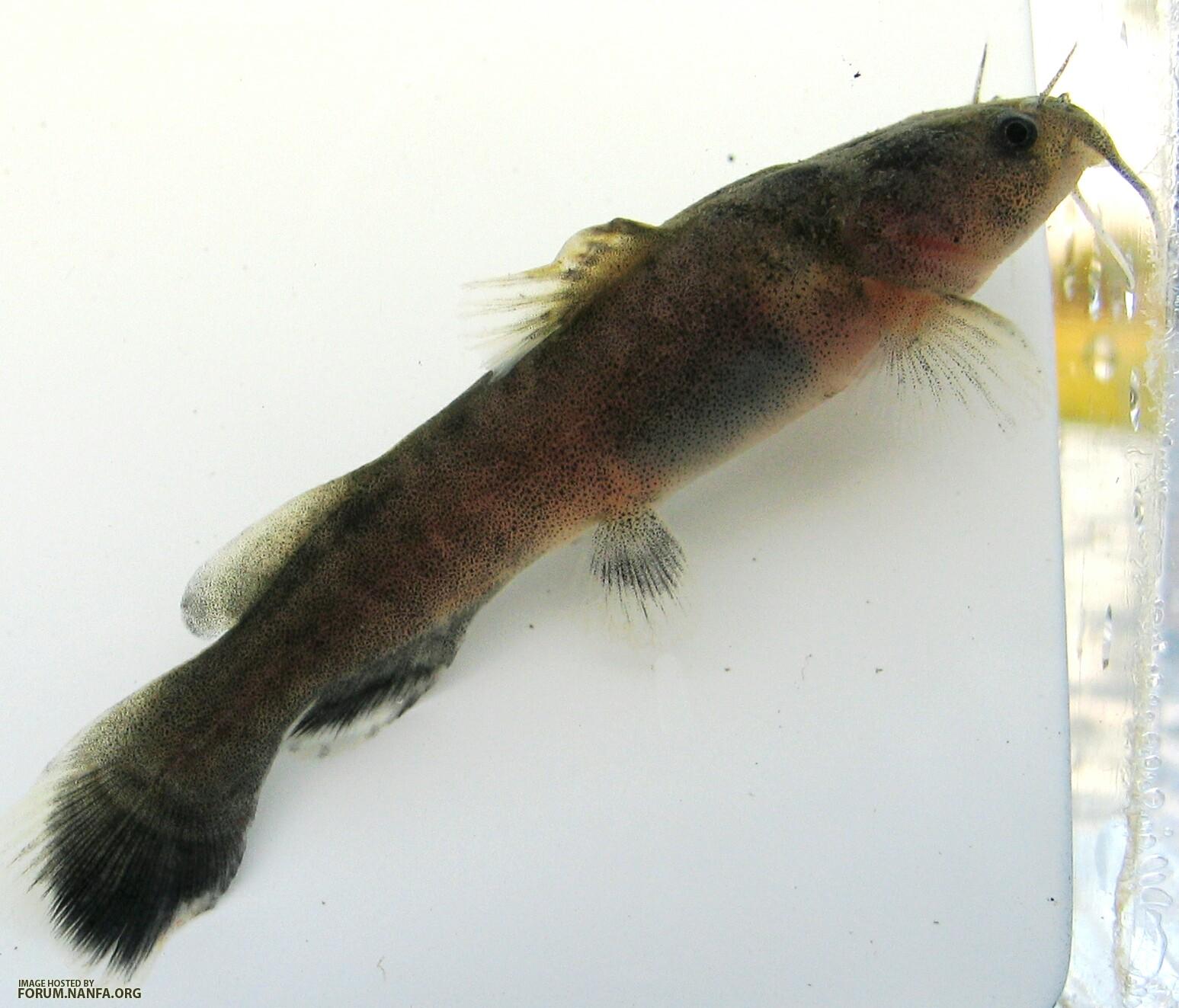Location: Blanchard River in Findlay, OH.
Water Level: 16 cubic feet per second. A gage height of 0.75 ft. (Average flow for this time of year is about 30 cubic feet per second)
Water Quality: The water was clearer than usual because it was pretty low. There is still plenty of siltation of the riffles and the bedrock at this section of the river however.
Water Temp.: 20.5*C
Substrate: Bedrock bottom with pretty good sized rocks in the riffles and runs. Many tree roots were underwater, which made for good madtom habitat.
Air Temp.: 70*F
Collected:
- Golden Shiner (Notemigonus crysoleucas)
- Spotfin Shiner (Cyprinella spiloptera)

- Redfin Shiner (Lythrurus umbratilis)
- Silverjaw Minnow (Ericymba buccata)
- Bluntnose Minnow (Pimephales notatus)
- Central Stoneroller Minnow (Campostoma anomalum)
- Suckermouth Minnow (Phenocobius mirabilis) – including one of the biggest I’ve ever seen.
- Creek Chub (Semotilus atromaculatus) – I found it a little odd that they were in the riffles and not in the pools that we sampled.
- Central Quillback Carpsucker (Carproides cyprinus hinei)
 - found quite a few of these from this year’s hatch in the pools below the riffles.
- found quite a few of these from this year’s hatch in the pools below the riffles. - Golden Redhorse (Moxostoma erythrurum)
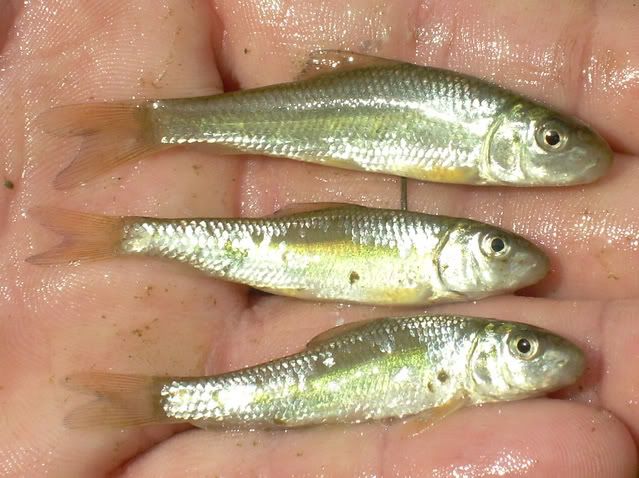 - lots of small young of year ones were found in the pools below the riffles.
- lots of small young of year ones were found in the pools below the riffles. - Northern Hogsucker (Hypentelium nigricans)
- Yellow Bullhead (Ameiurus natalis)
- Brindled Madtom (Noturus miurus)
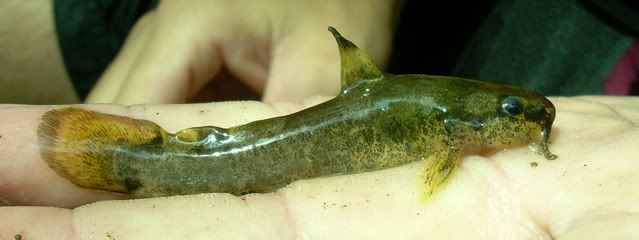 - that's a shot of one of the "regular sized" Brindled Madtoms that Mike and I encountered. The next 2 pictures are of a mammoth one that we caught right alongside a large log in shallow water. This same log produced about 6 madtoms...
- that's a shot of one of the "regular sized" Brindled Madtoms that Mike and I encountered. The next 2 pictures are of a mammoth one that we caught right alongside a large log in shallow water. This same log produced about 6 madtoms... 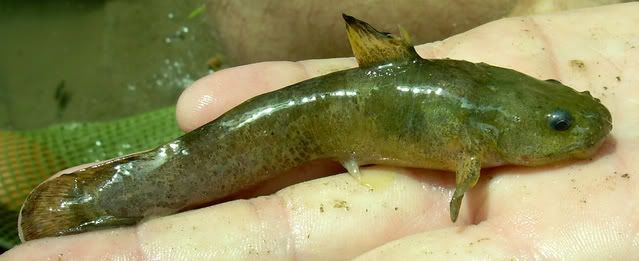
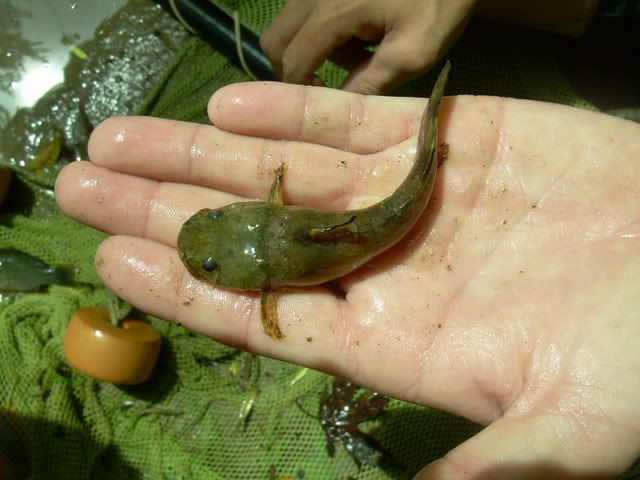 Mike and I almost called this Madtom a small Flathead Catfish at first, although this picture doesn't show it, there was no distinct adipose fin and the caudal fin was quite rounded.
Mike and I almost called this Madtom a small Flathead Catfish at first, although this picture doesn't show it, there was no distinct adipose fin and the caudal fin was quite rounded. - Green Sunfish (Lepomis cyanellus)
- Bluegill (Lepomis macrochirus)
- Largemouth Bass (Micropterus salmoides)
- White Crappie (Poxomis annularis)
- Rock Bass (Ambloplites rupestris)
- Northern Longear Sunfish (Lepomis megalotis peltastes)
- Hybrid Sunfish (Lepomis hybrid)
- Johnny Darter (Etheostoma nigrum)
- Greenside Darter (Etheostoma blennoides)
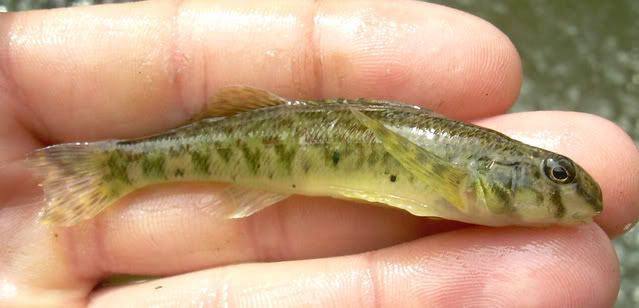 - lots of big adult Greenside Darters were found alongside large Rainbow Darters in good numbers in the riffles here.
- lots of big adult Greenside Darters were found alongside large Rainbow Darters in good numbers in the riffles here. - Fantail Darter (Etheostoma flabellare)
- Rainbow Darter (Etheostoma caeruleum)
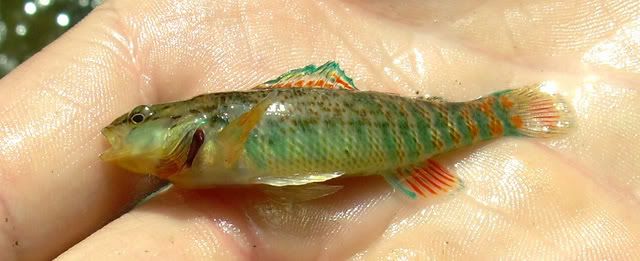
- Blackside Darter (Percina maculata)
- Logperch (Percina caprodes)
The second stop of the day was at a tributary to a tributary of the Blanchard River...here's how that went..
Location: an unnamed trib. to the Outlet Ditch of Springville Marsh, near Findlay, OH. (trib. to the Blanchard River).
Water Level: The water in the river was very low. Below summer averages. There weren’t any pools with depths greater than 2’ deep here. Most of the water here was so weed choked that it made sampling difficult.
Water Quality: The water was very clear, no recent rain to disturb the soil. The abundant plants probably provide some filtration for the water as well.
Water Temp.: (not measured)
Substrate: The substrate here is mostly sand with some fine gravel mixed in. There is a lot of vegetation in this ditch. Oftentimes when walking upstream, we weren’t even stepping on the sand bottom, but rather on the numerous plants.
Air Temp.: 70*F
Collected:
- Blackstripe Topminnow (Fundulus notatus) – no large ones, all young of year.
- Redfin Shiner (Lythrurus umbratilis)
- Central Stoneroller Minnow (Campostoma anomalum)
- Bluntnose Minnow (Pimephales notatus)
- Silverjaw Minnow (Ericymba buccata)
- Creek Chub (Semotilus atromaculatus)
- White Sucker (Catostomus commersoni)
- Creek Chubsucker (Erimyzon oblongus) – at least 50 young of year were caught here. Indications of a good spawn year.
- Green Sunfish (Lepomis cyanellus)
- Bluegill (Lepomis macrochirus)
- Rock Bass (Ambloplites rupestris)
- Grass Pickerel (Esox americanus vermiculatus) – only 3 were caught in an hour of seining.
- Orangethroat Darter (Etheostoma spectabile) – had a hard time finding these, they were buried in the vegetation.
- Rainbow Darter (Etheostoma caeruleum)
- Johnny Darter (Etheostoma nigrum)


